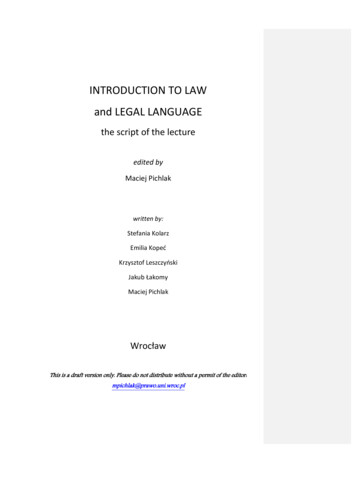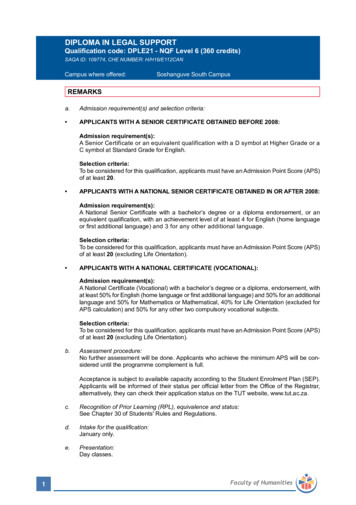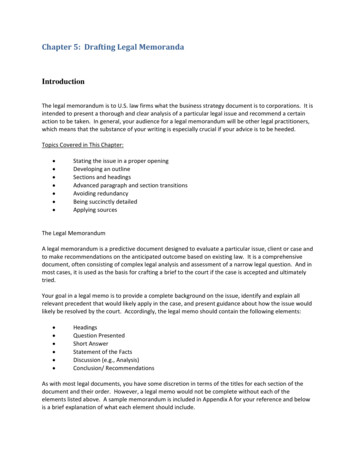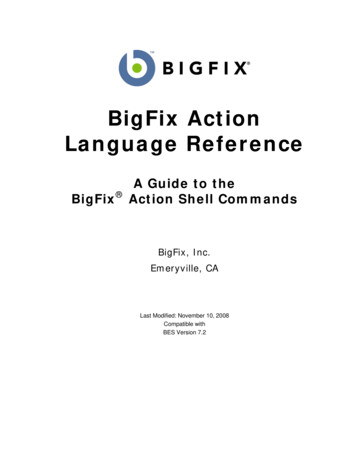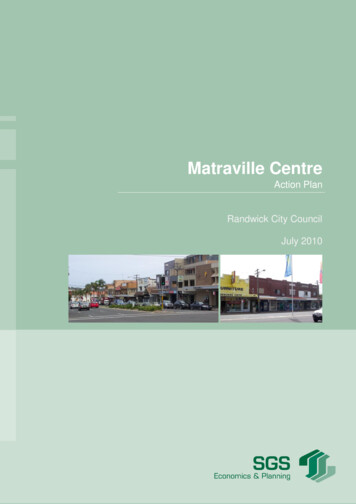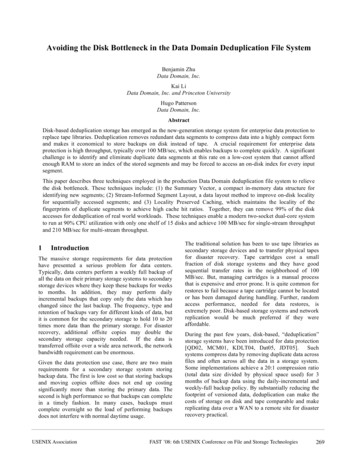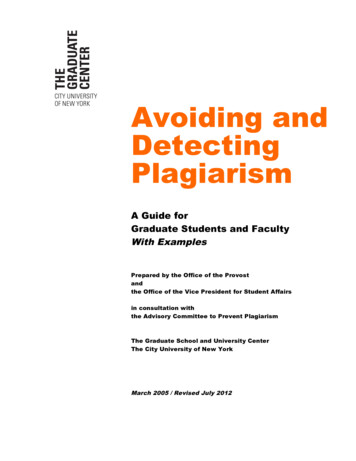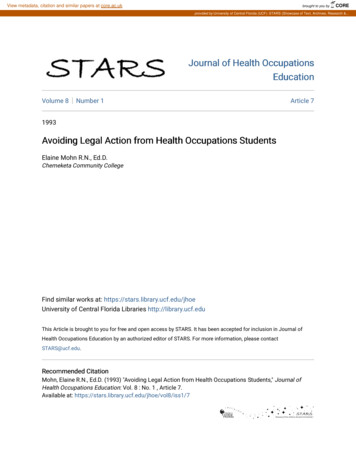
Transcription
View metadata, citation and similar papers at core.ac.ukbrought to you byCOREprovided by University of Central Florida (UCF): STARS (Showcase of Text, Archives, Research &.Journal of Health OccupationsEducationVolume 8Number 1Article 71993Avoiding Legal Action from Health Occupations StudentsElaine Mohn R.N., Ed.D.Chemeketa Community CollegeFind similar works at: https://stars.library.ucf.edu/jhoeUniversity of Central Florida Libraries http://library.ucf.eduThis Article is brought to you for free and open access by STARS. It has been accepted for inclusion in Journal ofHealth Occupations Education by an authorized editor of STARS. For more information, please contactSTARS@ucf.edu.Recommended CitationMohn, Elaine R.N., Ed.D. (1993) "Avoiding Legal Action from Health Occupations Students," Journal ofHealth Occupations Education: Vol. 8 : No. 1 , Article 7.Available at: https://stars.library.ucf.edu/jhoe/vol8/iss1/7
Mohn: Avoiding Legal Action from Health Occupations StudentsIJournal of Health Occupations EducationSpring 1993, Volume 8, Number 1Avoiding “Legal Action from Health Occupations StudentsElaine Nlohr?Abstract: Health occupations (HO) teachers increasingly are required to defendtheir decMons in court to fail students or dismiss students from programs. Legalprecedents have established several steps that HO teachers must take to protwtstudents’ rights to both procedural aud substantive due process. To justify the-wdecisions tQ fail or dismiss a student,HO teachers need to take spwific steps asthey develop course objectives and evaluate the performance of unsatisfactorystudents. HC9 teachers often experience emotional discord when they fail ordismiss students. However, the HO teacher is bound by professional ethics toensure that patients receive adequate care. To protect themselves and their<utions from the possibility of legal challenges, HO teachers should provideclear, unamb@ous explanations of all policies, criteria, and time frames towhich students are subject. Ehdne Mohn, R.N., Ed.D., is Second Level Coordinator? Associate Degree NursingProgram, Chemeketa Community College, Salem, OR.Published by STARS, 19931
Journal of Health Occupations Education, Vol. 8 [1993], No. 1, Art. 7Over the past 25 years, health occupations (HO) teachers have encounteredincreasing legal challenges from students who are dismissed from their programs.Because these dismissals threaten not only students’ personal career goals but theirfuture employability, students are more likely to seek court action for resolution.Moreover, teachers face a dual dilemma. If they fail a student or place them onprobationary status they could be involved in litigation. On the other hand, ifacademic dismissal is not tiltuted, patient safety could be jeopardized.Due Process and its Application to Health Occupations StudentsWhen students pursue legal action, they usually base their claims on violation ofthe Fourteenth Amendment’s due process and equal protection clause. D-al casesinvolve either procedural or substantive due process rights. Procedural rights consist ofthe steps used to protect and guarantee the rights of citizens (Spink, 1983). These rightscan be violated, for example, when an inMution fails to provide a hearing prior todismissal for disciplinary reasons. The landmark deckdon in Dmon v. Alabama StateBoard of Education (1961) afforded procedural due process in disciplinary cases forpost-secondary students. In contrast, substantive due process focuses on academicdeficiency in which the student faiIs to attain the required level of competency. Toclaim substantive due process, the intent of the law requires proving unfairness andunreasonableness in a teacher’s or institution’s dec lon regarding the dismissal. Thisarticle will present a review of several relevant substantive due process cases and adwcussion of their implications for HO teachers. As stated earlier, in cases of academicdismissal, the student faik to attain a specific level of competence. Lmandri s1/72
Mohn: Avoiding Legal Action from Health Occupations Studentsbelieves Connellv v. The University of Vermont and State AmicuRural Collegeestablished the basis for courts avoiding judicial interference in the educational processunless the decti on “. . . was motivated by m trariness, capriciousness, or bad faith.”In Greenhii v. Bailey (1975), Bailey both failed to hold a hearing and in a memo statedthat Greenhill “lacked intelhwtual abtity.” Whiie the court would not interfere injudging the student’s academic performance, it did chastise Bailey for not providingnotice of the charges. In addition, the court stated that an opportunity must exist forthe student to clear M#her name and to refute the allegations of academic dtilciencybefore the academic body which is responsible for the dismissal (Nkxiringhaus &0’DriscolI, 1983).The landmark case of the Board of Curators of the University of Missouri v.Horowitz (1978) addressed Horowitz’s claim that she was deprived of her liberty andprocedural due process rights. Horowitz, a medical student, argued that she had notbeen permitted to review her clinical evaluations and had not been not led of adiial hearing. The Board of Curators provided evidence that Horowitz had beengiven a warning about her performance, placed on probation, and then warned that shemight be dismissed. Even though the school had provided her with additional clinicaltime, she still failed her fiial examinations. Subsequently, she was asked to leaveschool. The Supreme Court left the evaluation of her academic abilities up to herprofessors and stated that she had been given more due process than was mqu”&ed.Nursing students’ dismissal for clinical incompetence was challenged in GasDar v.Muton (197S), Lvons v. Salve Regina College (1975), and Hubbard V. John Tv ler63Published by STARS, 19933
Journal of Health Occupations Education, Vol. 8 [1993], No. 1, Art. 7Communitv College (1978). While each case involved unique circumstances, only Lyonswon her case because the College breached the language in the student manual. Thecourt determined that to avoid breaching students’ due process rights, students must beinformed orally or in writing of their performance inadequacies and the subsequenteffect on their academic standing. Moreover; “. . . the school’s decision-making processmust be carefnl and deliberate” Nledringhaus & O’Driscoll, 1983, p. 158).The courts have established that teachers are uniquely qualifkd to evaluate astudent’s performances in the classroom and clhdcal settings, and governing boards ofschools also have delegated thii authority to teachers. Therefore, HO t chers mustdevelop course requirements and expectations for personal and professional behaviorsbefore student performance can be deemed insufficient and warranting dismisml. Morespecifkdy, classroom teachers shouldL Develop student behavioral objectives and publish them in the course syllabus.IIf the course is taught by a team, objectives must be developed jointly.2. Develop grading criteria for written work and print the criteria in the coursesyllabus. Be sure to include the penalty for students who submit late written work.3. Determine a process for handling failing papers, e.g., using a second grader orredoing the paper to achieve mastery of the underlying concepts.Teachers might consider duplicating the failing paper and placing it in thestudent’s fiie until hefshe passes or fails the course. Having examples of priorunsatisfactoW work may provide the foundation for winning a grievance and allows thenext teacher to thoroughly evaluate the student. If more than one person grades 4
written work,all gradersshouldupontheevaluationcriteria Studentsand implement themconsistently. Students compare the evaluative comments on their papers. Whengrading inconsistency becomes apparent, grievances are likely to follow.In the clinical setting, evaluation criteria for such cognitive, affective, andpsychomotor behaviors as fundamental knowledge, interpersonal relations, technicalskills, integrity, and professionalism must be developed. Besides determining broadcliical requirements, teachers must carefully identify the criteria for satisfactory coursecompletion as well as the consequences for unsatisfactory performance. As with thetlmoretical portion of the course, ciinkxd objectives and criteria must be printed in thesyllabus and student handbook. Additionallyq the teacher must decide the sources forevaluation input, for example, dwect observations informal feedback from health carestaff, and clinical preceptors. After the criteria are set, the teacher determines thefrequency for wnducting formal evaluation conferences. Remember, the law requiresthat students be apprised periodically of their performance.Further general due process guidelines include the following pointsL Distribute a copy of the student handbook to each student at the beginning ofthe school year. Provide a signature page which each student must sign and turn in thatstates helshe has read the handbook.2. Review all course documents with the students on entry into the program andeach subsequent school term as appropriate.3. Once a term has begun, do not alter course objectives or requirements.65Published by STARS, 19935
Journal of Health Occupations Education, Vol. 8 [1993], No. 1, Art. 74. Outline the steps in the student grievance process, publish them in the studenthandbook, and review them with the students at the beginning of each school term.With legal precedence being set by such landmark cases as Horowitz and Comelly,inatkutions must continue to deal fairly with students and accept internal accountabilityfor their decisions and decirion-rnaking processes. Once evaluation criteria areidentfled, written, published, and reviewed with the faculty and students, no one shouldbe misled as to the program’s requirements for satisfactory performance.Failing an Unsatisfactory StudentTeachers are hesitant to recommend remedial work or to fail the student who isperforming below minimum standards in the clinical component of a course. Reluctancearises in a teacher because cliical evaluations are subjective, often based on limitedobservations, and fear exists in being accused of having personality conflicts with thestudent. Hesitancy is compounded further when clinical objectives are broadly stated inthe syllabus, leaving room for open interpretation.Failing students who are performing poorly is mentally and physically draining tothe teacher. The teacher must spend extra time planning c mical experiences andclosely supervisii these students during the clinical experience. Supplementalconferences must be held with each student explaining h /her detlciencies. Even moretime is spent in the ritual of psyching oneself for these confrontations (Symanski, 1991).Another burden is added for the teacher when competent students are left to fend forthemselves while concentrating on the poorer student. Resentment builds agaiust astudent who in all likelihood will not /iss1/76—
Mohn: Avoiding Legal Action from Health Occupations StudentsBlaming oneself for the student’s inadequacies or one’s heavy workload will nothelp the student. Be careful of becoming immersed in a doom-and-gloom attitude overfailing a student. Yes, students can face financial and personal hardship because theymust wait a year before returning to the heidth occupations program. Howeverf keepasking: Is this student safe in the health care setting? Does aIlowing hidher tocontinue for fiiancial reasons justify the ‘burden placed not only on the next instructorwho will be the clinical supervisor, but also the ethics of permitting an incompetentstudent to work with patients? Always remember that one’s sixth sense or intuitionalbout student performance is usually correct.Another common probkxn is finding other HO teachers who have never failed astudent. They become hostile and angry when bxuming about a student failure bymaking such remarks as You are just too critical “ or “That student did wonderful inmy rotation!” Rather than arguing the dec lon with them, seek advice and guidancefrom an administrative director. He/she should be knowledgeable and supportive aboutthe decision as long as adequate documentation exists and the student’s due processrights are preserved. During the process of banding an unsatisfactory student, is notthe time to engage in phdosophical battles over beliefs in. failing student (Symanski,1991).Often heakh care professionals, who see themselves as caring and nurturingpersons, experience inner conflict over their deciAon. It is not an uncommon feeling.While guiding the student through remediation and possible failure, the teacher’sapproach always remain humane. However, caring and nurturing must be taken into67Published by STARS, 19937
Journalof HealthEducation,Vol. 8 [1993],Art. 7account for thepatients,too. ItOccupationsis neither humanenor ethkxdto allowNo.an1,incompetentIstudent to practice on patients.Having addressed the emotional issues surrounding student dismksal, let’s turn tothe actual evaluation process. The following guidelines are suggested:1. Develop a concise evaluation instrument with criteria denoting satisfactoryperformance.2. Develop an anecdotal notetaking process, being careful to note both positive andnegative clinkal behaviom. When only negative behaviors are documented, one can beaccused of having a personality conflict or of being unfair.3. Transfer the anecdotal notes to the formal evaluation instrument either daiiy orweekly to avoid omitting key observations.4. Keep a record of each student’s clinical assignment and other learningactivities.5. When deficiencies are noted, communicate the eoncems with the student eitherinformally in the clinical setting or formally with a written evaluation and conference.To verify whether the student understands the concerns, have hirdher reflect on theIconversation overnight and meet again with the teacher the following day to discuss any)misunderstandings.6. Develop a plan for improvement with specific timelines and consequences. Donot forget to document referrals to such bktutional resources as tutoring or counselingcenters. All parties involved should sign and date the written document.7. Once the plan for improvement is listed, follow it to the ss1/7.8
Mohn: Avoiding Legal Action from Health Occupations StudentsTable 1 is an example of a student progression plan that can be used to defiie astudent’s deficiencies and the subsequent plan of action.By including instructor actions, it illustrates that the phm is a collaborative effort.Administrators and school boards prefer that a conscious effort is made to help thestudent improve. By noting the time frames and consequences, the student is given adeilmite period of time in which remediation must occur and the outcome whenimprovement does not occur. Although this does not stop a student from fiig agrievance, it does show that one did not act in bad faith or in a capricious or arbitrarymanner.Always be prepared for a student grievance. Chant (1989) recommends thefollowing steps before a grievance is failed1. Review your grading criteria for clarity to a lay audience.2. Use standard forms and language across ali clinical courses.30 Review your insthtional policies on the grievance procedure for amb ity.I4. Ensure that the dismissal criteria are ckarly stated.5. Seek support of the d-al process from the school’s administrators.6. As&t the school’s administrators to understand how H(3 studenta differ from.those in non-vocational programs.Although failing an unsatisfactory students is diffhlt, one does not fail students,Ithey fail themselves! When student evaluations are based on sound profmsionalIstandards and judgment and are conducted without malice, the courts uphokI teachers’deckdons. The key intervention strategies are to establish concise course requirements,69IPublished by STARS, 1993I9
IJournal of Health Occupations Education, Vol. 8 [1993], No. 1, Art. 7Table 1Exanm!e of Problem-Solvinz RecordProblemPlan of ActionViolation of Chemical Safety1. 4/10/92, 8:00 a.m. John enteredH.R.’s room to administer an IMmedication. He failed to check thepatient’s armband or double check themedication record before giving themed. I reminded him to foIIow the“5 Rights of Administering Medications.”1. John will administer allmedications following the “5 Rightsof Administering Medications. ”2. John will develop and implement aplan to avoid omitting medications inthe future.2. 4/10/92, 1030 a.m. John was givinghis 10 a.m. medications when he discoveredthat he had omitted H.R.’s MO a.m.Dlgoxin. MD was notMed. D oxin w a sgiven at 1045 a.m. and an incident reportwas fried.3. At the beginning of each clinicalshtit, John must be prepared to state thedrug’s actions and side effects as wellas correlate all medications and IVsolutions to the patient’s diagnosis.4. The instructor will observe Johndminister medications to aU of hupatients for one week (4/24 & 4/25/92).3. 4/17192. John was unable to statethe side effects and ratiomle for hispatient receiving Procardia, Apresoline,and Aldomet. He stated he did not havetime to research h medications eventhough he received h assignment on4116192.5. If no further violations of chemicalsafety occur by the end of the quarter(6/7/92), this plan will be discontinued.6. If further violations of chemicalsafety occur, John’s progression in thesecond-year will be reviewed by thesecond-year team and the Dwector 8/iss1/710
Mohn:Avoiding LegalAction from HealthOccupationsStudentsuse completedocumentationand communicationtechniques,and providefeedback asIwell asthe opportunity to correct the deficiency in a timely manner. Adhering to legalprecedence may seem overwhelming at fiit, but, once familiar with it, teachers shouldfeel more comfortable with their teaching career.ReferencesIBoard of Curators of the University of Missouri v. Horowitz, 435 U.S.(1978).IDiion v. Alabama State Board of Education, 294 F.2d 150 (5th Cir. 1961).Gaspar v. Iknton. 519 F.2d 843 (lOth Cir. 1975).Grant, A. (1989). Dealing with a student grievance. Nurse Educator, M, 13-17.Greenhill v. Bailey. S19 FQd 5 (8th Cir.N75).IHubbard v. John Tyler Community College. 455 F. Supp. 753 (1978).Mmandri, B. (1981]. Academic procedural due process for students in the healthprofessions. Journal of Nursing Education, , 9-18.Lyons v. Salve Regina College. 422 F.Supp. 843 (1973,Wdringhaus, L. & O’DriscolI, D. (1983). Staying within the law--kademic probationand dismissal. Nursinr Outlook, 31, 156-159.Spink, L. (1983). Due process in academic dismissals. Journal of Nursing Education, , 305-306.ISymanski, M. (1991). Reducing the effect of faculty demoralization when failiigstudents. Nurse Educator, , 1S-22.IPublished by STARS, 199311
Journal of Health Occupations Education, Vol. 8 [1993], No. 1, Art. 7https://stars.library.ucf.edu/jhoe/vol8/iss1/712
Associate Degree Nursing. Program, Chemeketa Community College, Salem, OR. 1 Mohn: Avoiding Legal Action from Health Occupations Students Published by STARS, 1993. Over the past 25 years, health occupations (HO) teachers have encountered . Nursing students' dismissal for clinical incompetence was challenged in GasDar v. Muton (197S), Lvons .


